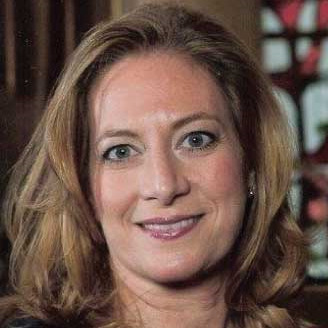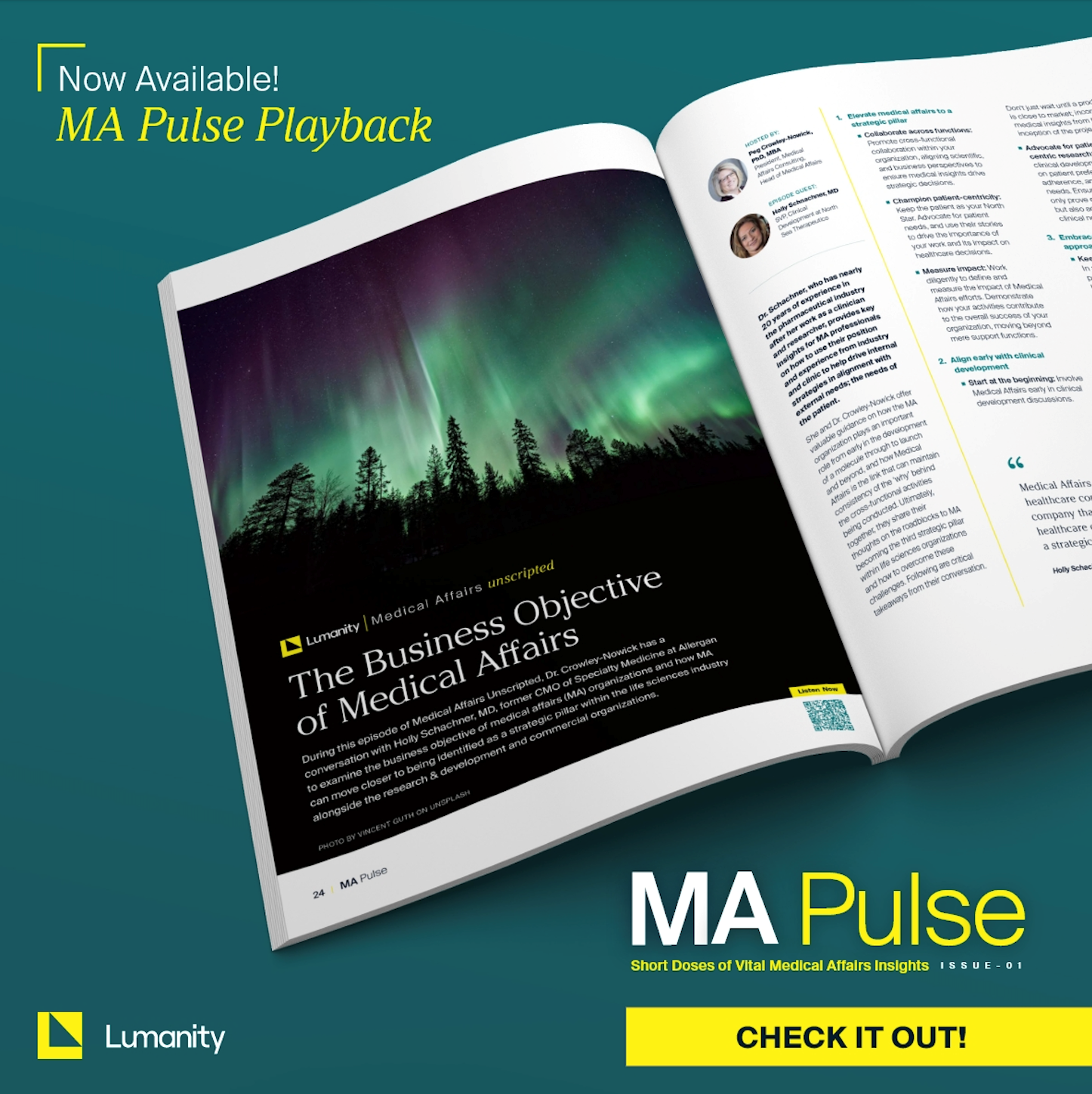Episode 2 of the Medical Affairs Unscripted podcast series recorded by Zipher, now part of Lumanity
During this episode of Medical Affairs Unscripted, Dr Crowley-Nowick has a conversation with Holly Schachner, MD, former CMO of Specialty Medicine at Allergan to examine the business objective of medical affairs (MA) organizations and how MA can move closer to being identified as a strategic pillar within the life sciences industry alongside the research & development and commercial organizations.
Dr Schachner, who has nearly 20 years of experience in the pharmaceutical industry after her work as a clinician and researcher, provides key insights for MA professionals on how to use their position and experience from industry and clinic to help drive internal strategies in alignment with external needs; the needs of the patient. She offers valuable guidance on how the MA organization plays an important role from early in the development of a molecule through to launch and beyond, and how MA is the link that can maintain consistency of the ‘why’ behind the cross-functional activities being conducted. Ultimately, Dr Schachner shares her thoughts on the roadblocks to MA becoming the third strategic pillar within life sciences organizations and how to overcome these challenges.
Podcast Series: Medical Affairs Unscripted
Hosted by Dr Peggy Crowley-Nowick, in Medical Affairs Unscripted we explore a range of topics related to the strategic role of medical affairs from the perspective of industry experts. Through these conversations with our guests we will share first hand experience to provide the listener with insights and knowledge about the evolving role of medical affairs.
Podcast transcript
Peg Crowley-Nowick 0:32
Welcome to the first season of medical affairs unscripted. I’m your host, Peg Crowley-Nowick, president and founder of Zipher Medical Affairs, a full-service consulting firm. During this podcast, we’ll explore a range of topics related to the strategic role of medical affairs from the perspective of industry experts. Through these conversations with our guests, we will share firsthand experience to provide the listener with insights and knowledge about the evolving role of medical affairs. Please stay tuned at the end of the podcast to learn more about Zipher.
Peg Crowley-Nowick 1:18
Today, we are joined by Holly Schachner, the former CMO of Specialty Medicine at Allergan Pharmaceuticals. How are you today, Holly?
Holly Schachner 1:25
I’m fine. I’m very happy to be here, Peg. Thank you for having me.
Peg Crowley-Nowick 1:30
Holly, on today’s episode, I want to discuss the business objective of medical affairs. I want to understand how medical, in your mind, how medical affairs organizations can move closer to becoming the third strategic pillar of a pharmaceutical organization, and what it takes to be an effective medical affairs leader. I’d like to start this podcast by asking a question about your experience. And what I’m looking for is, during the years that you’ve been involved in medical affairs, can you give me an example of a time when you said, aha, this is what medical affairs is all about? And I see it. And I feel it. And I know what the impact is?
Holly Schachner 2:14
Thanks for the question. And I would say that in my close to 20 years in the industry, I have been fortunate enough to have several of those aha moments where I get to pinch myself and say, I’m so lucky that I get to do what I do every day. But I would say the first there are two that actually strike me. The first was as I was preparing for the launch, for a product that is geared towards a very specialized patient population. And knowing that medical had such a strong voice in guiding the company, to which patient population that should be, rather than going so broad and trying to get this specialized medication to the broad masses that, let’s say finance or marketing may want to get to, but for the current time, our data and the clinical needs really fell to a very specific patient population, and having the opportunity to then lead the lifecycle plans so that we could then explore other patient populations that would benefit. That was very exciting. I would say the other time where it was really important, when I really looked at all the different functions that we do in medical affairs was actually when we pulled a product from the market, not because of safety, but because of sales. It was a very innovative product. And we had a lot of ongoing clinical trials. And we had a lot that we could learn. And it was so innovative that there were other companies who still wanted to learn from us. So, using the patient as our North Star, we said okay, what do we do? The company doesn’t want to promote this or sell this anymore. But we know from a clinical perspective, we need to publish all the data we need to complete certain clinical trials. And we need to ensure that patients could still get this product, even though we weren’t selling it. They needed to get what we had available and took the bold move and walked into a board meeting and said we can do this. Let’s work with regulatory, let’s put patients first. And that was a great moment early on in my career in industry.
Peg Crowley-Nowick 5:09
It’s exciting to listen to that on two different examples. But in both cases, it was medical affairs taking the lead — demonstrating leadership, going out in making a strategic decision, and then going out and arguing for it to get what you needed to support the brand to support the patients. Let’s just take a step back then, because I think that ties beautifully into the topic today. Medical affairs, in my opinion, is a very important part of every pharmaceutical organization. However, over and over again, I hear they’re a support function, they provide support to the commercial team, they provide support to the regulatory team to the clinical development team. If you need something done, call medical, they can support you in that, when in fact, if you read any of the new literature, and you work with anybody who’s in medical affairs, you hear that we’re really the third strategic pillar. And that’s the strategic pillar, with commercial and with research and development. However, as much as that’s the vision, I’m not really sure that medical affairs has attained that yet in the full respect of the organizations. Yet as the world is evolving, as the market is evolving, and as the pharmaceutical industry is changing, it’s more and more important for medical to step up and to really take charge as that third strategic pillar. So, your story goes right along with what our topic is today. And those are the aha moments and very exciting to hear. I’d like to take a minute, though, to take a step back and talk about how you even became involved in medical affairs, you were in clinical practice. And your career has taken you on a trajectory that has led you to the CMO position. Could you tell me a little bit about your history?
Holly Schachner 7:05
Sure. So, I was born in Fort Hood, Texas, no, no you don’t want to go that far back. I was practicing pediatric endocrinologist at a large academic center, where I had responsibilities for the clinical care of patients and their families, as well as doing clinical research. So, when I took on a clinical role, I didn’t expect to have research in my purview. And the first day at a large academic center, they dump a grant on front of your desk, and they say, give me the research. So, I was doing clinical care and research, really enjoying everything that I was doing. But at some point, I felt that I wanted to have a little bit more with translational research and make an impact beyond the patients that I was seeing, even though my patients are so very near and dear to my heart. And I actually had the opportunity to speak with somebody from a large company, who my friend’s mom worked for him. And he was so generous with his time. And I spent probably more than an hour on the phone with him. And he spoke to me about how pharmaceutical companies are set up. What are the different roles within R&D, medical affairs, commercial market access, I remember even speaking about regulatory — I had no idea that drugs were regulated that that was what the label was for. And he was very generous with his time. And he gave me advice in terms of looking at my skills, looking at what I found the most rewarding throughout my day and throughout my week. And I also then took it upon myself to reach out to a former professor of mine from medical school, who I know had gone to the industry, who I respected tremendously. And I was scared at first to reach out to him he was this professor, and you know, you revere them, and you think they’re never gonna remember me. They’re not going to take my call. I said that, you know, if he doesn’t remember me, he doesn’t take my call. I won’t speak with him. But if I don’t reach out to him, I won’t speak to him either. So, reached out and I don’t know if he was lying or not. But he was like, Of course I remember you. Let’s meet and happy to speak with you again. Very generous with his time, spoke with me about medical affairs and he actually said he’s like, I know you and he said, I know some of your patients, and I know the work that you do from advocacy. I know the people you do research with, he said, I really do believe you need to find a role within medical affairs. And that was enough for me. So, I sought out a role in medical affairs, and I have not looked back,
Peg Crowley-Nowick 10:23
Which is a great story, because a lot of people enter through the development side, and then eventually based on personality and desire and what their interests are, it drives them into medical affairs, but you started in medical affairs, so it fits perfectly with your personality. And over the years that I’ve worked with you, I think that you made the right decision.
Holly Schachner 10:44
I got guidance, and I listened to their guidance.
Peg Crowley-Nowick 10:49
In your transition starting as a medical director?
Holly Schachner 10:52
Yes, I was actually a medical director in a group that was called Medical Regulatory Services. So, I was the medical arm for legal regulatory and medical review. And honestly, I think that every clinician coming into industry should rotate through that should do, I learned that there was a label, I learned all the data that we have on product, I learned all the data that we had that went into our medical information letters, all the data that we promoted off of, all of our IIT data, I knew everything inside and out. And I also saw what our consumer marketers wanted to say I saw what our healthcare professional marketers wanted to say. And I saw our market access people, what they wanted to say. And I actually encouraged them to be more consistent. I said, your messages, your scientific messages need to resonate, you may be working at it from a different angle. But the people that are seeing this are seeing it from the same point of view, don’t confuse them. Let’s be consistent. And I think that that was the first time commercial was like, “Oh, you have a point.”
Peg Crowley-Nowick 12:25
Well, it sounds like it was a perfect training ground. Because you also, from that training period, you probably see where the gaps are in the data and gives you a better perspective on what you need in order to deliver that message.
Holly Schachner 12:41
Absolutely!
Peg Crowley-Nowick 12:41
In order to put a narrative together and be able to tell the story.
Holly Schachner 12:45
It was. And I would say it also connected me to a lot of people within the team, I was able to see the cross-functional workings, how well one could work when you’re working with commercial, with regulatory, with legal, and with your medical colleagues as well.
Peg Crowley-Nowick 13:08
And from my perspective, that’s one of the most important aspects of any medical affairs professional is that they can work in a cross-functional situation, that they have strong leadership skills, because they’re not just there to listen, they’re also there to lead and to work with their cross-functional partners to go towards a common vision.
Holly Schachner 13:27
Correct.
Peg Crowley-Nowick 13:27
And when I’ve worked with you over the years, I’ve seen that that’s the way you take charge from a leadership perspective. So, when you think about a medical affairs team, what constitutes a medical affairs team?
Holly Schachner 13:45
So, you know, it’s interesting, I’m gonna go back to a little bit of what you had said earlier, in terms of often medical affairs is viewed as a support function. There are times where folks in medical feel like they are a rubber stamp, I just need medical to sign this. And I’ve been known to say, “No, I’m not going to sign it.” That’s my signature. That’s my name. I’m going to have colleagues who are going to be reading this, and they know I work for this company, and they’re gonna say, that’s what you’re saying about this particular disease state. That’s not okay. So, I take it very personally. And I think we all need to put ourselves on the other end of material that we’re reading, data that we’re reading, what kind of data that that we want, and it becomes personal. They also feel that, instead of it being the bridge that gets walked on as some people will say, we need to be the link. And I often think of those toys where you know, sometimes you pull really hard and you’re stuck together. And other times you need to relieve pressure. But we’re educators, and we are a link between external and internal as well, I find that very often, our teams are very inward facing. And we think about what the business needs, what the business needs, what the business needs. And if we can be so bold and open and say, the business needs what actually the external world needs. And we can create something. But if there’s no need externally, it’s not going to be successful. So, I’ve also been known to say to heads of R&D, when we all get paychecks, when we get approvals from the FDA, then you can be the end of the line. But we actually get paychecks when we actually get products into the hands of patients that need it. And I view that to be one of the key roles of medical ensuring from different pillars, that the products that we make, whether they’re devices, whether they’re drugs, whether they are behavior guides that we develop, when the products we develop get into the hands of patients that we need. That’s when we’ve done our job well.
Peg Crowley-Nowick 16:38
So, that’s a beautiful segue into what I think is the business objective of medical affairs. Because what I find so often when I talk to folks in different companies is they tell me what they tactically do. They write publications, they engage with thought leaders, they bring back insights, they have a lot of meetings and workshops to identify data gaps, and they have a way to work on ISTs. But when I asked them the why, what’s the why behind all of that, I get a lot of different statements, but nothing that gives me clarity. And to me, if you don’t have that clarity, and you don’t understand that business objective perfectly, then it gets more challenging. So, from my perspective, I think that that business objective is to make sure that the right information is in the hands of the decision makers, which are your healthcare providers, the payers, and the patients who are all making decisions. If they can’t make informed decisions, then that medicine can never get to the person that needs it. So, access is denied if they don’t have the information. And it’s medical that does that, from developing new data, developing the narrative and delivering it to the right people. It’s really an important aspect. Yet not everybody thinks that way. So, how do you? How do you work with your team to bring those pieces together to keep telling that story to get people to understand what you’re really trying to do, rather than just doing the tactics?
Holly Schachner 18:16
So, first, you make sure that you partner with really strong consultants who can help you bring that voice? You know, like somebody at Zipher, just saying,
Peg Crowley-Nowick 18:31
Well, we appreciate that.
Holly Schachner 18:36
So, first and foremost, I’d like to encourage and ensure that the teams are working in a cross functional way. And I think that we need to make sure we’re working in a cross functional medical way. That means that our pubs folks, our scientific communication folks, our IIT’s and phase four, are all aligned with the same strategy. Okay, these are all and I hate to say that we’re all levers in something that we execute against, but it is — why are we doing these things? Are we laddering up to a broader strategy, very similar to when I told the consumer marketer and the HCP marketer and the market access marketer, that our message would be consistent if we were surround sound, it’s the same thing from a medical perspective. So, first, we need to align on our scientific platform and make sure that our medical strategy is based on true patient need and based upon a good assessment of the external world. And then the more we can align as a cross functional medical team, the stronger and more powerful we can be when we go outside of medical to communicate why we need to do certain things, so that we hear a consistent voice, and that we ourselves are truly committed to what we’re doing. And it enables us to say, No, we’re not doing that. Because a lot of times I asked my team, why are we doing this? If the answer is because commercial wants it, it immediately does not get funded. They have to earn that funding back. Explain to me, why did commercial want that and we as medical don’t do things because commercial tells us to do things, we can certainly have conversations, we can certainly have conversations around our strategy, we as medical, decide what activities we’re doing, we need to have a good reason. And it needs to align with our medical strategy. And I would rather do less that aligns more with our strategy because that surround sound is going to be so much more powerful.
Peg Crowley-Nowick 21:17
Right, bringing everybody together. So, we’ve talked a little bit about commercial, how about research and development? And how does medical affairs fit in with the R&D group?
Holly Schachner 21:30
I think medical affairs needs to lean into clinical development a lot. I’ve been part of programs where we’ve had about patient preference, there was nothing about adherence, there was nothing about, you know, certain needed aspects within certain patient populations, they were all a little bit broad. If medical leaned in a bit more to the clinical development program, when we got approval, we actually would have had a label that not only showed safety and efficacy, but actually showed true clinical need and patient need. And I think that that would have helped. And, again, going to my conversations with heads of R&D, I get that we need certain studies to get approval, regulatory approval. Absolutely. That’s important. That’s foundational. That’s not enough anymore. We need to have more.
Peg Crowley-Nowick 22:50
And thinking about that. Where does medical — within the development side, when should medical be involved? Because medical is expensive. It’s an expensive unit. So, you, you think about the fact that the commercial team wants you to focus that energy on anything that’s close to market, and making sure that that’s all taken care of — But if you’re not thinking about the future by working with clinical development, then you’ll lose in the long term. Where do they get involved? Where does it make a difference? And how can you do that in a cost-effective way?
Holly Schachner 23:28
So, I think the most cost-effective way to properly utilize any of the expertise within a company is to make sure that people have the right skills and capabilities, and one needs to develop them for what the role requires. Not just for today, but for tomorrow. So, I believe that the right medical affairs talent leans in, even at the very beginning, it’s the original, why it’s the original, what’s the patient need, we can develop any product, okay, we can develop a multitude of pharmaceutical treatments. But why are we doing that? So, being part of the conversation, they don’t necessarily have to have veto power or go/no-go decision power, but they need to have input they need we need our patient voice. Those external insights brought in early in development, and throughout each part of development. That’s my perspective.
Peg Crowley-Nowick 24:45
I really enjoy that perspective and fully believe in it. Do you see it happening?
Holly Schachner 24:53
I see it happening in pockets. I see it happening in rare disease. I see it happening in very specialized therapeutic areas, not just in rare but another specialized areas of oncology possibly. And I think that in different companies, there could be different cultures where it may be more of a crossover. But I don’t see it everywhere.
Peg Crowley-Nowick 25:29
No. So, in order to reach that point where medical affairs is that third strategic pillar, then they have to have that voice at the table, on the development side, and the voice at the table on the commercial side and be able to actually contribute in a useful way, so that they can incorporate that into the strategy.
Holly Schachner 25:53
Correct.
Peg Crowley-Nowick 25:55
If you’re thinking about us moving to that point, and let’s say we’ve reached the perfect world, hopefully that happens in the next few years, as you see more and more medical professionals coming into the industry, we see so many physicians joining industry, I have the opportunity to work with some great medical affairs professionals, who understand development, understand commercialization, really get the data and still remember what it’s like to be in clinical practice. But what is missing what’s holding back medical affairs from making that next move, and really, truly becoming a third strategic pillar?
Holly Schachner 26:35
So, I’ll tell you that when I first joined industry, the guidance that was given to me, not by the people who I actually spoke with, to decide to go into industry, but by other people who thought they were being mentors.
Their advice was, “Remember, don’t speak for three months; Get to know people; (and) You’re not the quarterback anymore.” So, that was very interesting advice. I think, one out of three ain’t bad — “Get to know people.” I think that that’s important. I think that, if I can tweak, “You’re not the quarterback anymore” — In clinical practice, you were the final decision maker, if I could tweak that to say, “You bring one perspective, you need to listen to other perspectives in order to fully understand and make a good decision for the company for the product.” That would be good. As you know me, Peg, I’m not one to keep my tongue tied.
Holly Schachner 27:56
And I think it’s important for people to impart their wisdom, their external knowledge, their insights from dealing with patients, because that’s why all of us should be doing what we’re doing. That’s why all of us are at the table. And there have been times where I didn’t start a conversation unless I related it to a patient. I have slide decks that have my own family members on them. And I was the HR made me get, you know, signed documents from my father to you know, and he was very happy to do so I have to tell you, I’ve never gotten so many emails thanking me for sharing that story.
Peg Crowley-Nowick 28:56
So, it’s important to keep the patient as the North Star.
Holly Schachner 29:00
Absolutely!
Peg Crowley-Nowick 29:00
It’s important to not lose sight of where you came from. It’s important to lead…
Holly Schachner 29:07
Yeah.
Peg Crowley-Nowick 29:08
…to share your knowledge, and to share that with other leaders in the company and not be afraid to do that, to stop being just the support, but to actually understand the why and to share that knowledge.
Holly Schachner 29:23
Correct. And I think, for the why and for the business impact, we need to tie it into the impact, and it’s very hard to measure impact from a medical perspective. But we need to work hard to keep doing that, to try and find it, to define it to people.
Peg Crowley-Nowick 29:48
And as soon as you do that, you start to see people working together as a team because it isn’t about the fact that I just published something. It’s about the fact that something was published, that the MSLs are using it, that you’ve seen it presented somewhere, that people are talking about it, that the materials are there, that it’s actually making a difference, that maybe an advocacy group is interested and then will talk to their patients. So, all of that then takes a single message and can turn it into something that has value as it grows and is amplified across many different channels. So, medical affairs has a very strong voice. And with great leaders like you, it’s our opportunity to become that third strategic pillar. And I’m very excited to have had the chance to talk with you today and to share your stories. Is there anything else that you’d like to finish off with?
Holly Schachner 30:41
No, I really appreciate the opportunity. I’m very excited. I also think that one of the images or hopes that I give to folks who are on my teams who I’m speaking to about what a career in medical affairs should look like. I think that medical affairs needs to be the guiding post for a health care company of the future. That we’re not just a company that sells a pharmaceutical product, but we are a health care company of the future. And who better to be a strategic partner than medical affairs?
Peg Crowley-Nowick 31:26
Perfect ending. Thank you so much, Holly.














